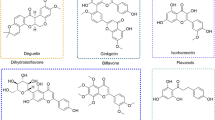Abstract
We investigated the effect of the flavonoid quercetin (Q) on the proliferation of the ovarian cancer cell line OVCA 433. Growth experiments demonstrated that Q exerted a reversible dose-dependent inhibition of cell proliferation in the range of concentrations between 10 nM and 10 microM. Two other flavonoids tested, rutin and hesperidin, were ineffective in inhibiting cell growth. Cell cycle analysis showed that the growth inhibitory effect of Q was due to a blocking effect in the GO/G1 phase. Using a whole cell assay with (6.7-3H) oestradiol (3H-E2) as tracer we demonstrated that OVCA 433 cells contain type II oestrogen binding sites (type II EBS). Competition analysis showed that Q competed for 3H-E2 binding to type II EBS while both rutin and hesperidin did not. Appreciable amounts of type II EBS were also detected in seven primary ovarian tumours. Our results suggest that Q may regulate ovarian cancer cell growth through a mechanism involving a binding interaction with type II EBS. This mechanism could also be active in vivo since primary ovarian tumours contain type II EBS.
Similar content being viewed by others
Author information
Authors and Affiliations
Rights and permissions
About this article
Cite this article
Scambia, G., Ranelletti, F., Panici, P. et al. Inhibitory effect of quercetin on OVCA 433 cells and presence of type II oestrogen binding sites in primary ovarian tumours and cultured cells. Br J Cancer 62, 942–946 (1990). https://doi.org/10.1038/bjc.1990.414
Issue Date:
DOI: https://doi.org/10.1038/bjc.1990.414
- Springer Nature Limited
This article is cited by
-
Thermodynamics of complex formation between hydroxypropyl-β-cyclodextrin and quercetin in water–ethanol solvents at T = 298.15 K
Journal of Thermal Analysis and Calorimetry (2019)
-
Host–guest inclusion complex of quercetin and hydroxypropyl-β-cyclodextrin
Journal of Thermal Analysis and Calorimetry (2017)
-
Fabrication of cyclodextrin nanosponges for quercetin delivery: physicochemical characterization, photostability, and antioxidant effects
Journal of Materials Science (2014)
-
Effects of luteolin and quercetin, inhibitors of tyrosine kinase, on cell growth and metastasis‐associated properties in A431 cells overexpressing epidermal growth factor receptor
British Journal of Pharmacology (1999)
-
The two phyto-oestrogens genistein and quercetin exert different effects on oestrogen receptor function
British Journal of Cancer (1999)




